Visiting Acanceh Mayan Ruins - The Complete Guide
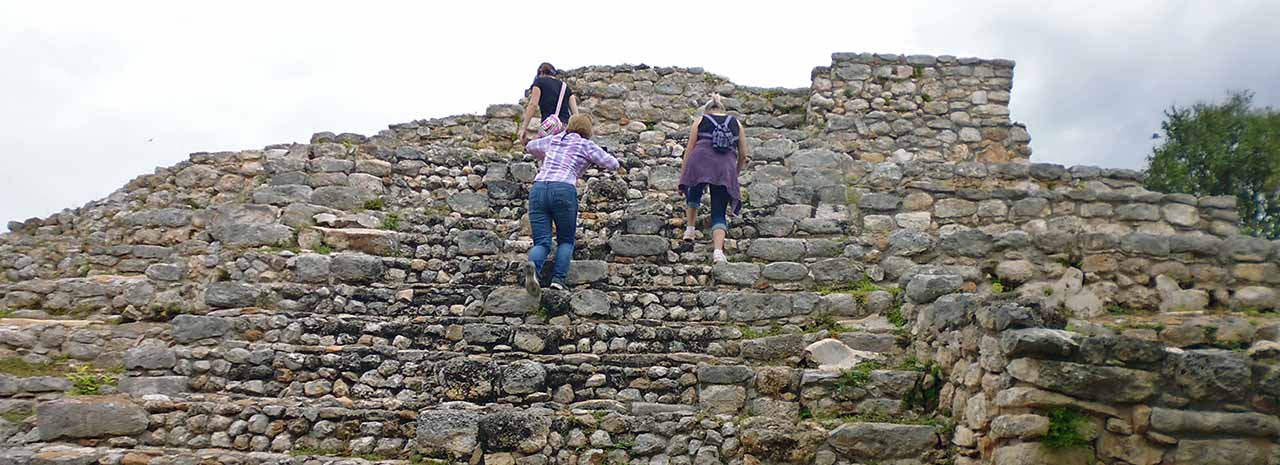
What makes visiting Acanceh Mayan Ruins so great? When you think of Mayan ruins, you’re first thought probably goes to Chichen Itza or Uxmal. However, there are Mayan ruins in the Yucatan that are much smaller, yet have unique features that make them worth a visit. Acanceh Mayan Ruins is one such set of ruins.
What makes these ruins so interesting is that they are in the middle of the town! The main pyramid is located next to the town cathedral and across from the town square car park. Intriguingly, these ruins have survived in the town, despite the Spanish invaders’ habit of destroying almost anything Mayan when they could.
We always enjoyed visiting Acanceh Mayan Ruins as they are very different from the bigger ruins we tend to visit with overseas friends. There is less to see but what there is fascinating. It’s also not in one place. To get from the pyramid to the Palace of Stuccoes, you have to walk through town!
The guys at the gate of the pyramid were very helpful. After we paid the (cheap) entrance fee and looked around the pyramid, one of them walked with us to open the gate to the Palace.
As a day trip from Merida, this is a great destination. What makes it really good is visiting Acanceh Mayan Ruins can be followed by a trip to Uxmal Mayan Ruins or a visit to one of the many cenotes around Homun. All in the same day!
Personally, when we’ve taken people, we don’t mix Acanceh with any of the bigger ruins. Acanceh Mayan Ruins have a quaint small feel that is best matched with a nice dip in a cenote.
Visiting Acanceh from Merida
A day trip to Acanceh from Merida is very easy. It’s a relatively short distance of 15 miles (25km) and you have several options.
Tours to Acanceh Mayan Ruins – and elsewhere!
You can take one of the many tours offered in Merida. As you probably won’t need long to explore the Acanceh Mayan Ruins, these tours will combine Acanceh with various other destinations. You might get a combination of Miyapan and Acanceh as you pass through the latter on the way back from Miyapan. Alternatively, you may wish to combine it with a cenote. It’s not far from Homun and we’ve managed to take friends to Acanceh and visit two cenotes on the same trip.
Driving to Acanceh Mayan Ruins
If you’re driving, it’s only about 25 minutes from Merida. Take the Periferico toward Cancun on the 180 and aim for Teya. Just past Teya, look for the 184 on your right. It’s then straight on to Acanceh. The roads are good, although remember to slow down for the small towns – when you hit your first speed bump (tope) you’ll understand why slow is best!
Taxi and Bus to Acanceh Mayan Ruins
A taxi might cost you MXN300 one way but check first and remember it could cost more to get back. Another option is to hire the driver for the trip or for the day.
The bus is straightforward. Unlike many Mayan ruins where you end up in the middle of nowhere, with Acanceh you arrive in the town square. Getting a return bus is also much easier, with places to get a drink while you wait for the bus. Allow between MXN 30 and MXN 70 for a return. The journey is roughly 30 to 40 minutes depending on where you start in Merida and which bus company you use.
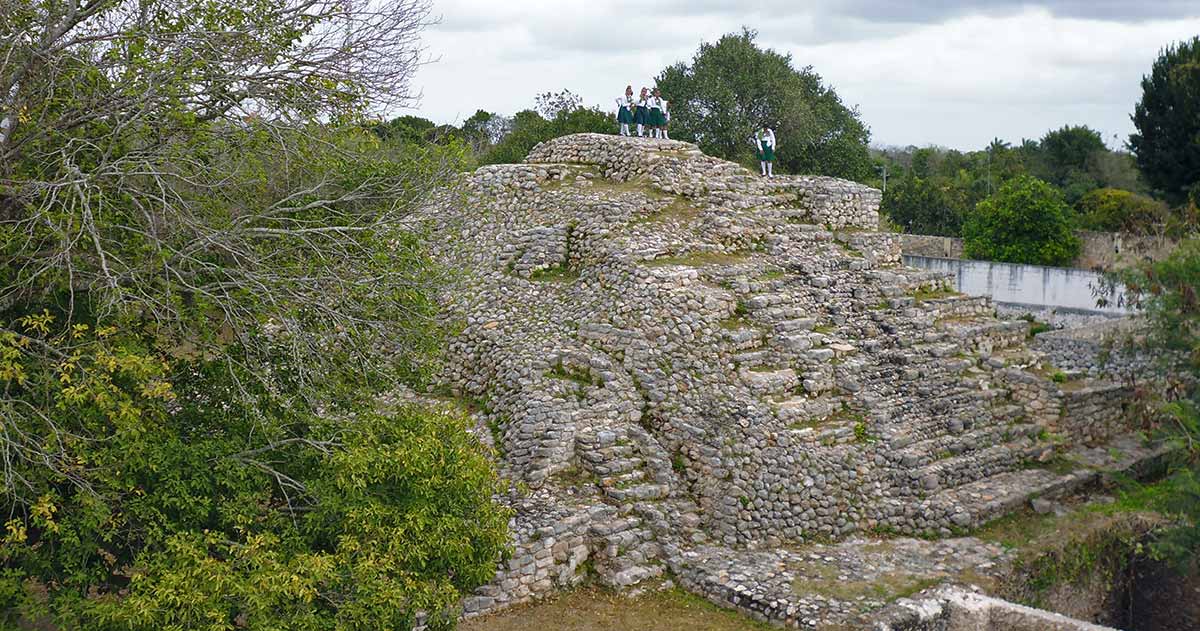
What do I need to know when visiting Acanceh Mayan Ruins?
What is the cost to enter the Acanceh Mayan Ruins?
The entrance cost for visiting Acanceh Mayan Ruins is now MXN75. That’s a big jump from the MXN40 we paid on our first trip just two years ago, but still very reasonable compared to many other sites.
Click here to check the latest price as it may go up again: INAH
The ruins are open from 8 am to 5 pm daily.
What should I bring when visiting Acanceh Mayan Ruins?
- Cash
- Sunscreen and a hat (for the walks between sites)
- Good walking shoes both for the pyramid steps and for the walk through the town
- Water, drink, and food are available from the town square
Are there any restrictions at the Acanceh ruins?
There is a standing ban on drones at all archaeological sites but other than that there are no other restrictions I’m aware of.
What’s the best time to visit Acanceh?
Acanceh Mayan Ruins are not a major tourist attraction, so it is rare to find it crowded. Aside from small school tours each time we’ve visited, we’ve been the only tourists.
The normal warning applies regarding the Yucatan sun – try to avoid midday in the summer months as it can get very hot. There’s some shade at the top of the pyramid but waking to the other sites can be hot in the sun.
How long should I allow when I visit the Acanceh Mayan Ruins?
This depends on your interest in Mayan culture and history. You need to add the time taken to walk from the Pyramid to the Acropolis and to the Observatory. The latter would be a quick visit.
We’ve always enjoyed climbing both pyramids and sitting on the steps watching the town, as well as looking at the masks. The Palace of Stuccoes took us longer on our first trip as we spent a long time looking at the frieze and going in and out of the rooms.
You could probably do it all in two hours comfortably. Faster if you’re short of time and longer if you want awesome photos of every nook and cranny!
Don’t forget to spend some time in the town of Acanceh. The market is fascinating and there is a nice deer monument in the plaza.
The town of Acanceh
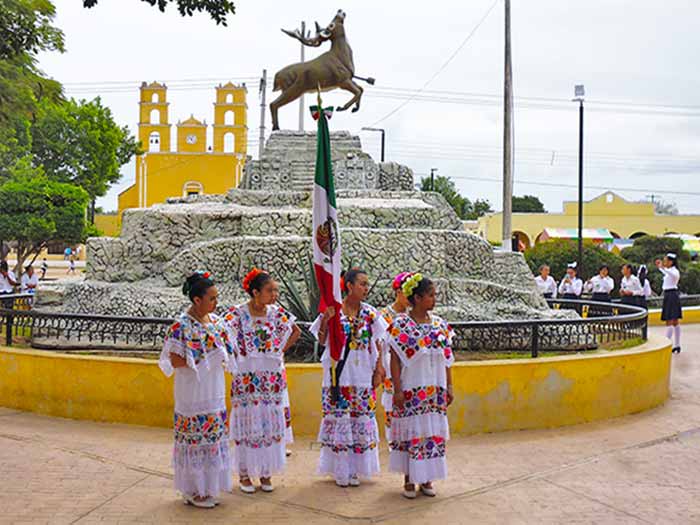
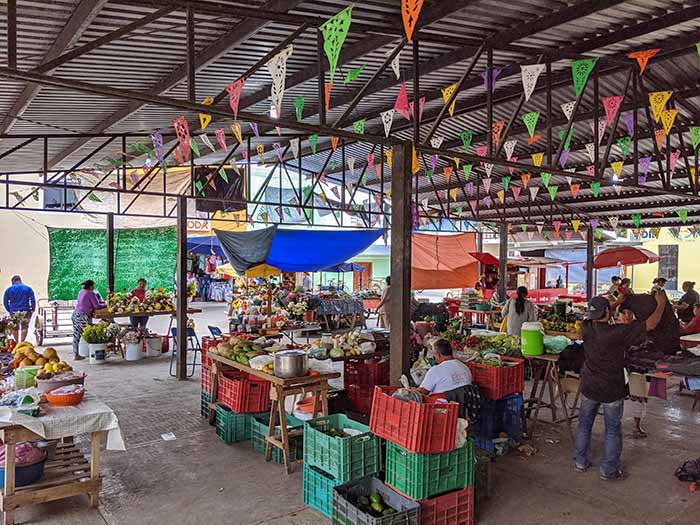
The population of the town of Acanceh is mainly Maya and around 11,000 people.
Archaeologists believe that the town sits on top of the remains of a large pre-Columbian Mayan site. Although only three Mayan structures are open to the public, it is believed the ancient city had between 300 and 400 structures at its height. It covered an area of about 1.5 square miles (about 4 square km).
What is amazing about these ruins is that the Spanish invaders didn’t demolish them. Normally, especially so close to an inhabited town, the temples were destroyed as part of the attempt to wipe out the old religions.
Where did all the ruins go?
It’s not hard to see where many of the old Mayan buildings ended up. Walking along the streets, you will see many garden walls made up of what were once parts of the old city. The inhabitants have systematically done what the Spanish didn’t. Which is to slowly dismantle the Mayan city.
Who can blame them? And they’re not the first or last to do it. The correct term for this is spolia, which refers to the re-use of ancient building materials for later construction. It happened (and is still happening) around the world. But it’s probably more evident in Acanceh than anywhere else!
Acanceh (pronounced Ah-Kahn-KAY) is a Mayan word, believed to mean ‘cry or moan of the deer’. The deer features heavily in Acanceh tradition. It appears on the municipality shield. There is also a large statue in the town square of a deer, complete with an arrow in its chest.
The Acanceh Mayan Ruins are right across the road from the big car park. Check out this video
Is it worth visiting Acanceh Mayan Ruins?
If you have the time, then I would say ‘yes’. The Acanceh ruins are unique and easily accessible from Merida. You can easily combine a visit with a trip to another ruin or some cenotes.
If you’re short on time or can only visit one Mayan ruin on your trip to the Yucatan or Mexico, then I would suggest either Uxmal or Chichen Itza.
Realistically, visiting Acanceh is really only practical if you’re already in the Merida area. It’s nearly two hours by car from Valladolid and even further from the Riviera Maya.
Structures to look out for
The one down side when visiting Acanceh Mayan Ruins is that they are not all in the same place. There are three main structures and you will need to walk through the town to get to the different ones.
But it’s an easy walk, so enjoy the local scenery! We’ve seen some lovely birds and interesting plants as we’ve walked about the town.
The Main Pyramid
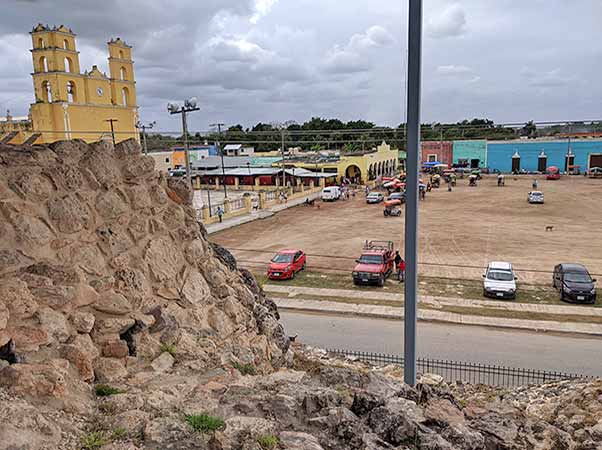
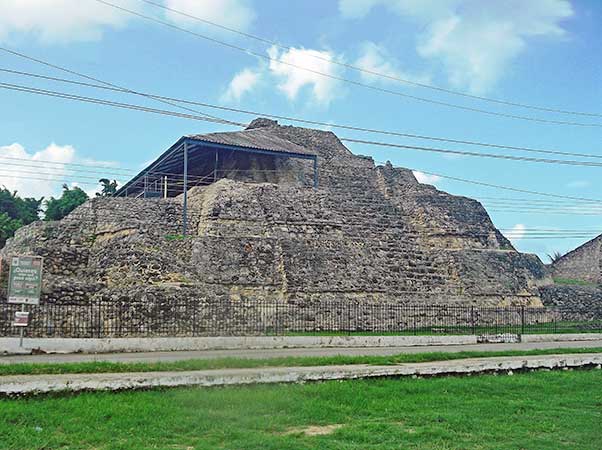
When visiting Acanceh Mayan Ruins, you will inevitably start at the pyramid next to the town square.
Typically known as Structure 1, the pyramid is about 37 feet (11m) high, ascending in three tiers. It’s easily climbable, which is the only way to access the masks at the top.
The pyramid you can climb is not the original structure. Another pyramid was found underneath it. On this pyramid were found 5 amazing carved stone masks. Part of the ‘new’ pyramid has been removed to allow access to the old masks.
The early structure has been dated to between 700 BCE and 200 CE, predating any Yucatan Mayan influence. (The dates are open to question and vary considerably depending on which archaeological work you rely on – but it is very old!)
The discovery of a burial chamber under the floor of the chamber excited archaeologists. The human remains discovered in the chamber may be those of important figures.
Some parts of the early pyramid show signs of thick stucco, even with red paint. When you visit, try to imagine the pyramids painted red!
The Five Acanceh Masks
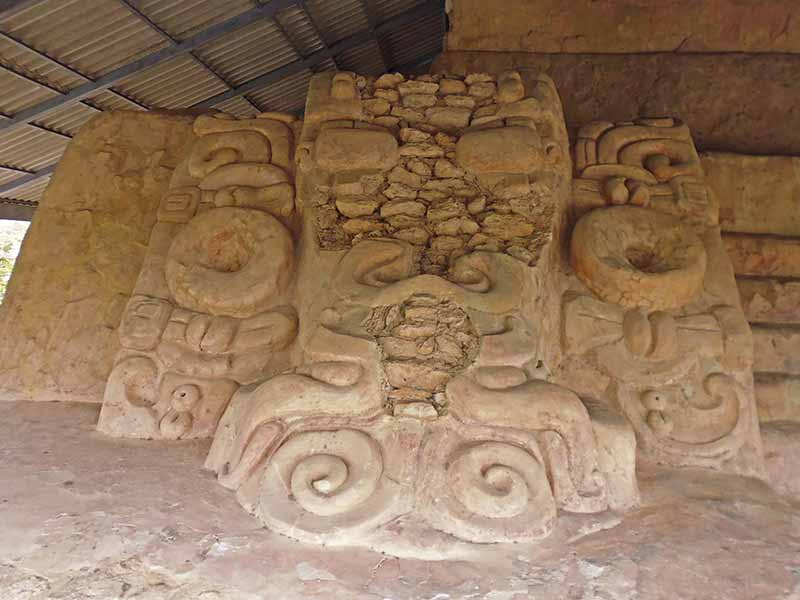
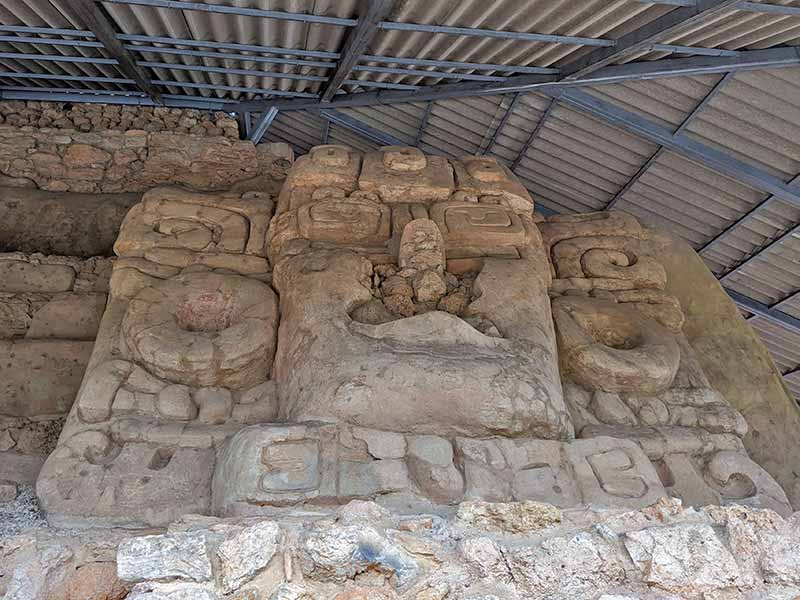
The masks are protected by a (rather unsightly) steel roof. This is better than the old thatched roof which caught fire during a firework celebration and damaged some of the stucco work.
There are five masks, although there were originally eight, two on each side of the pyramid. They are big, some nearly 7 feet high
The style of the masks is similar to those found in sites in Guatemala and Belize from the early Maya periods of 200 BCE to 300 CE. There is some evidence that these Mayan sites were also influenced by Teotihuacan invaders but so much is still unknown.
Second Pyramid (Structure 1B)
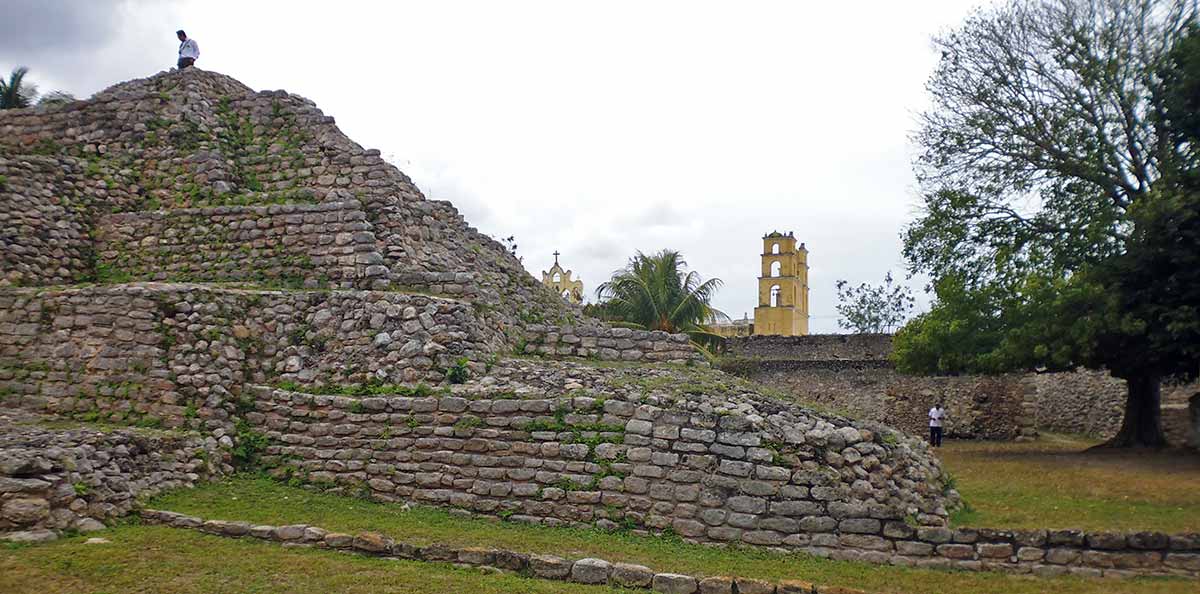
Behind the main pyramid is a smaller one called Structure 1B, about 15 feet (4.5 m) in height. This is also climbable, giving good views over the remains of the ‘jungle’ to the rear.
There was a third pyramid noted by Charney in the 1880s but this was apparently cannibalized to make the local railway station!
Acropolis and the Palace of Stuccoes
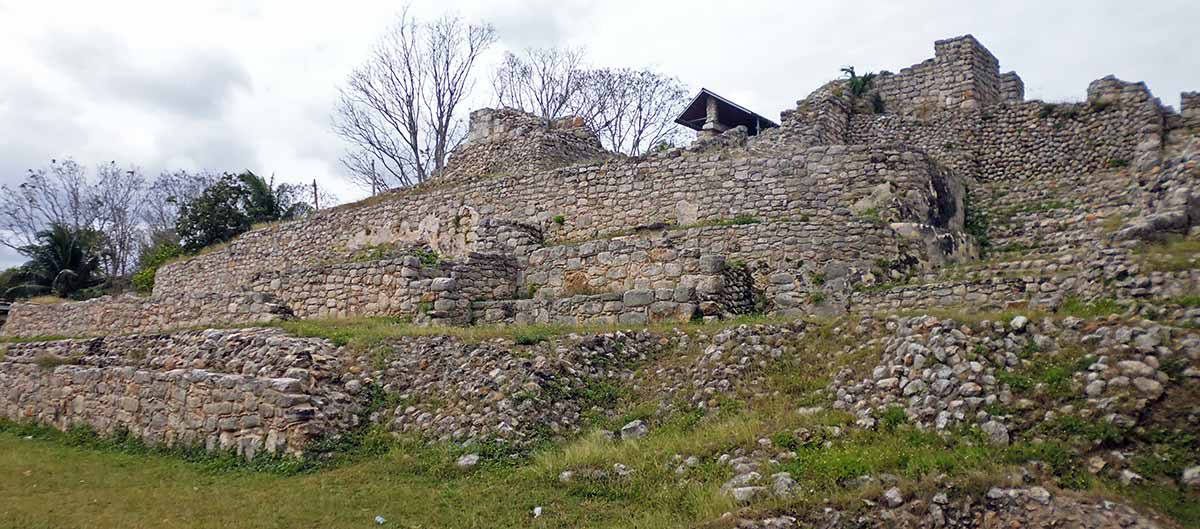
The Palace of Stuccoes is just one of a series of buildings that make up the Acropolis. Much of the Acropolis has only fairly recently been excavated as part of work done by INAH and Beatriz Quintal Suaste.
The Acropolis has a large base measuring about 163 feet by 26 feet (50m by 8m), topped by many smaller buildings.
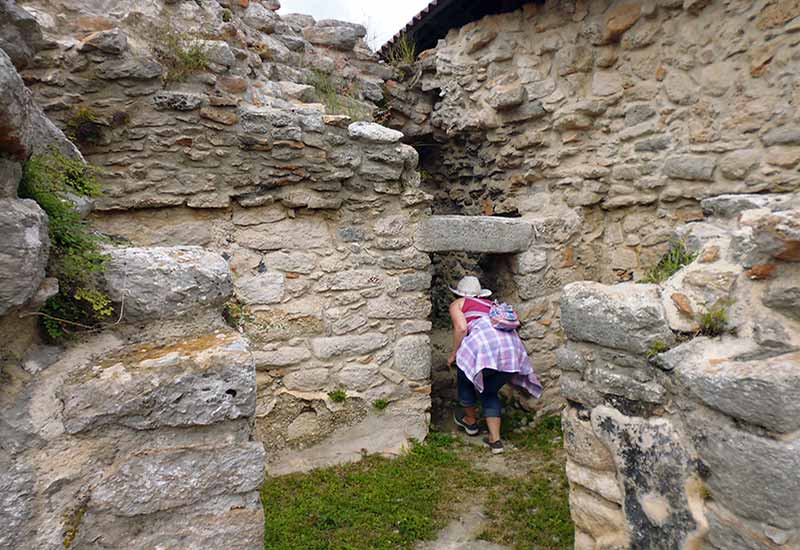
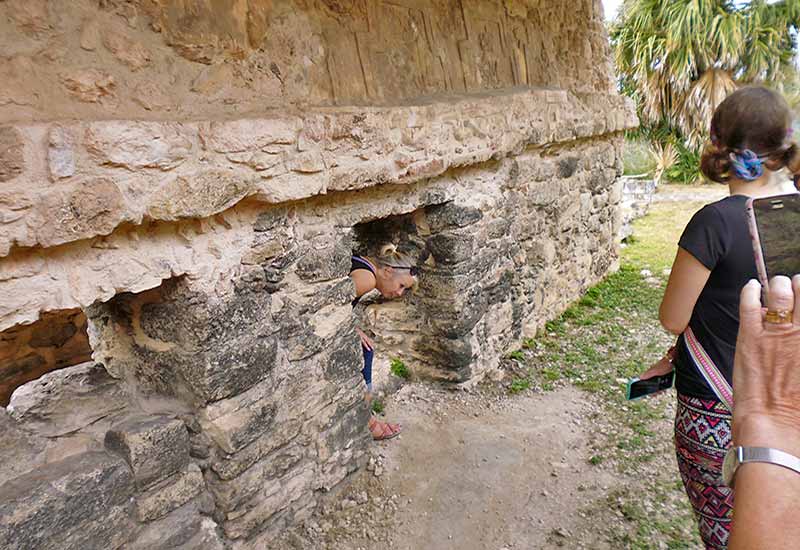
Palace of Stuccoes
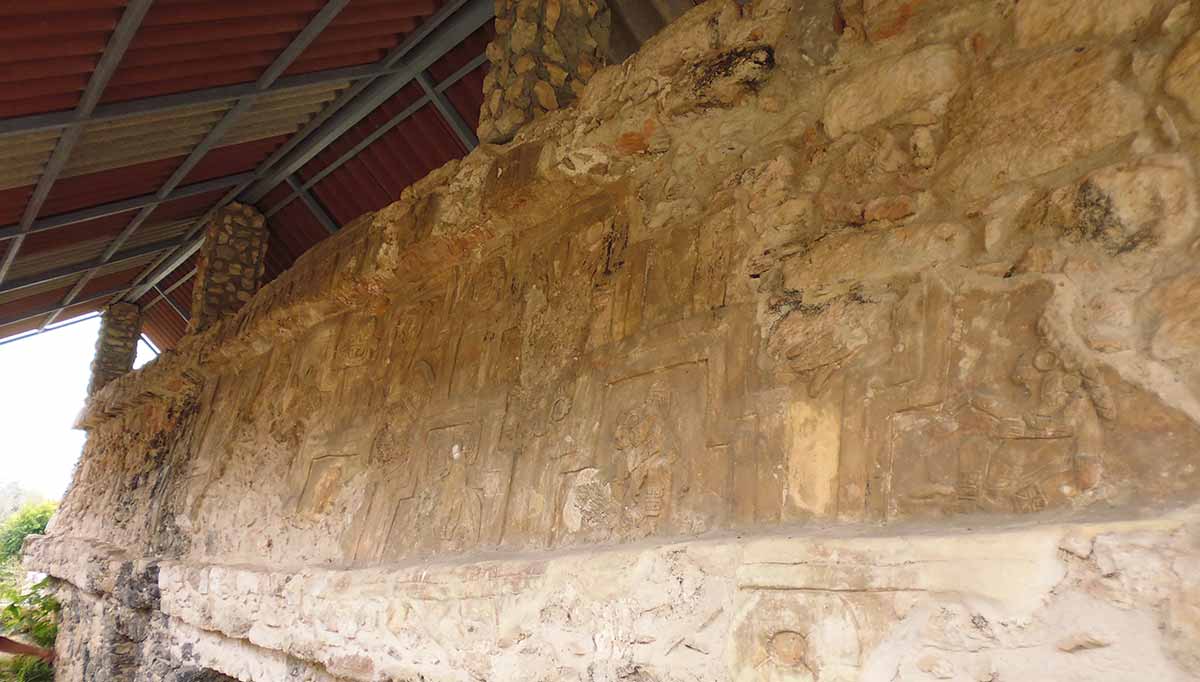
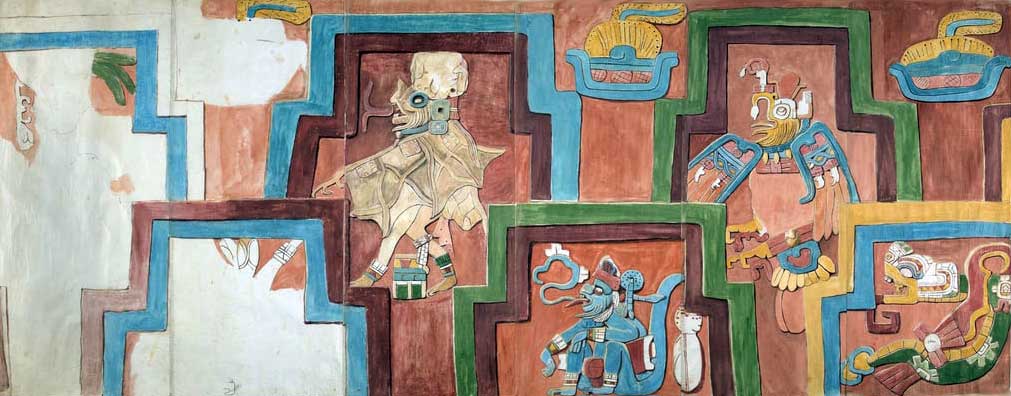
The Palace of Stuccoes was initially unearthed in 1906 by local residents, rather than archaeologists. Sadly, finding this amazing building wasn’t part of the locals’ goal – they were simply trying to gather building materials!
The ‘Palace’ (using Maler’s name) is about 160 feet wide and 20 feet high (50m by 6m). There are several little rooms and small doorways.
Since it was first unearthed, this structure has attracted a lot of attention. This is mainly due to the amazing frieze on the north-facing facade. This is, or rather was, one of the best surviving examples of Mayan art. The size and scope of the frieze are unique.
When found, it was 5 and a half feet high by 49 feet long (2m by 15m). The frieze had 20 molded figures, many still with their original bright colors. The figures were and are a mystery. There are deities, birds, and animals. But what do they represent? Figures from the underworld, Zodiac-related icons, or something quite unrelated.
As with much of the Acanceh ruins, the style of the frieze is reminiscent of the Teotihuacan style.
Sadly, due to vandalism, neglect and exposure, most of the colors are gone and some of the carvings have been defaced or destroyed.
To get to the Acropolis/Palace of the Stuccoes, walk down Calle 16. It’s only a short walk and you can check the garden walls to see where the rest of the Mayan ruins went!
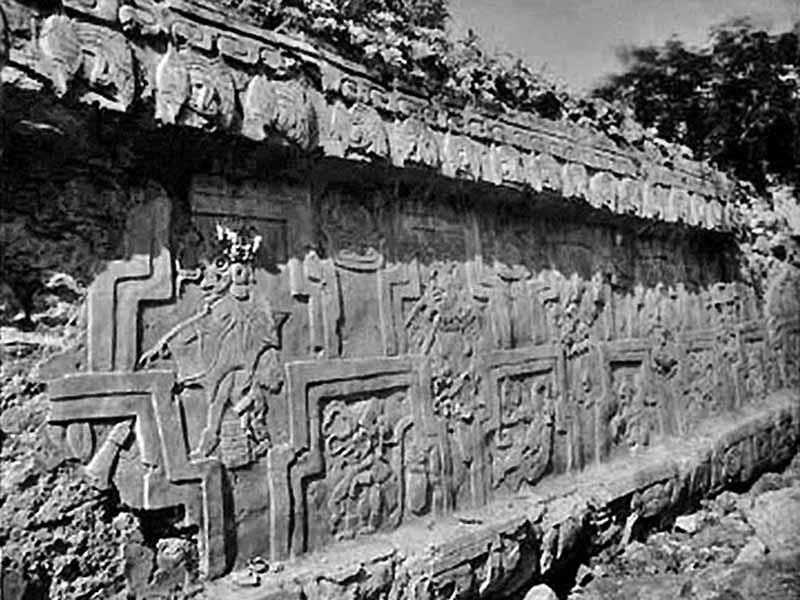
Observatory of Venus
Beatriz Quintal Suaste has also made some amazing discoveries in the town itself. In 2002, she and her team unearthed a semi-circular structure now called Structure 6. Archaeologists have confirmed this was an underground observatory used for astronomy.
Built between 200 CE and 600 CE, it was part of a larger structure, most of which has disappeared, leaving mainly the base and some low walls.
The observatory is a small structure, with barely space for one person. It is about twice as high as it is wide but access is through a narrow opening. Several papers have been written on its design and purpose. It is aligned with both the sun and the planet Venus. Venus had special significance for the Mayans. The Mayans knew the Venus deity as Noh Ek.
To visit the Observatory, leave the Pyramid and walk along Calle 21 towards Cuzama. It’s on your left down a small road,
History of Mayan Acanceh
Archaeologists believe that the site at Acanceh has been occupied from as early as 350 BCE (some even say 700 BCE). They also consider this site to have been occupied continuously since then. That makes it one of the few sites in the region to have been inhabited, without a break for over two thousand years.
Acanceh and Teotihuacan invaders (or traders)
The history of Acanceh is complex and interesting. The stuccoes show great similarities to those found in the ruins of Teotihuacan, an ancient city in central Mexico, about 25 miles (40 km) to the northeast of Mexico City.
There is uncertainty and debate among archaeologists about the relationship between the Teotihuacan peoples and Acanceh. Due to the timing of the rise and fall of the Teotihuacan ‘empire’, this has varied between invaders and traders.
It appears that the Teotihuacan ‘empire’ faded about the time that the different Mayan populations increased. Teotihuacan architectural and religious emblems are now being recognized in many Yucatan Mayan sites. This is especially the case with Acanceh. This is adding to the view that the Teotihuacan influence may be due to trade rather than invasion.
Acanceh is old!
What is not open to question is that the ruins at Acanceh date back perhaps at least as far as 300 CE, which predates most of the ruins in the Yucatan! The question arises – was the population at the time even Mayan? The debate is still underway.
Some archaeologists suggest that the city was at its peak in the mid-700s CE, earlier than most of the other Yucatan Mayan sites. (These dates are all freely debated among archaeologists).
Later, when the Mayan city states of Chichen Itza, Mayapan, and Dzibilchaltún were in full power, around the 1000 CE period, Acanceh was still strong enough to have good relationships with its neighbors. However, as those city states declined, so did Acanceh.
Modern History of Acanceh
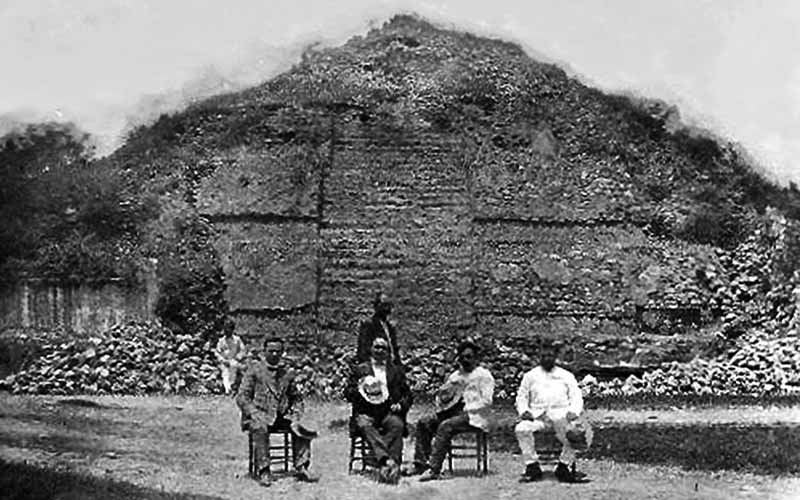
The ruins at Acanceh didn’t have the same impact on the international scene as Chichen Itza and Uxmal. They were not so much discovered as stumbled across. The ruins were well-known in the town but not viewed as much more than a source of building materials.
The French photographer Desire Charnay took many photographs of Mayan ruins using primitive equipment during his visits to Mexico from 1857 to 1861 and again in the 1880s. In 1881, he was aware of what would now be a third pyramid but that was cannibalized for stones to build the railway station!
Charnay’s book ‘The Ancient Cities of the New World’ published in 1887 is the first mention of Acanceh in the West in connection with ruins.
Others followed – slowly. In 1906, some villagers uncovered the now-famous frieze. Teobert Maler visited in 1908 and took photos of the frieze, giving it the name Palace of the Stuccoes. He also unearthed the pyramid.
Edward Seler made several trips to Mexico between 1887 and 1910 but probably after Maler. He published a paper on the Acanceh frieze in 1911.
In 1966, Instituto Nacional de Antropología e Historia (INAH) took on the oversight of the ruins.
In 1996 restorations started and continued as more structures came to light. A great deal of work was done in 1997 and 1998. Since the early 2000s, Beatriz Quintal has made more discoveries, including the Observatory of Venus.
Adela Breton and the Colors of the Frieze
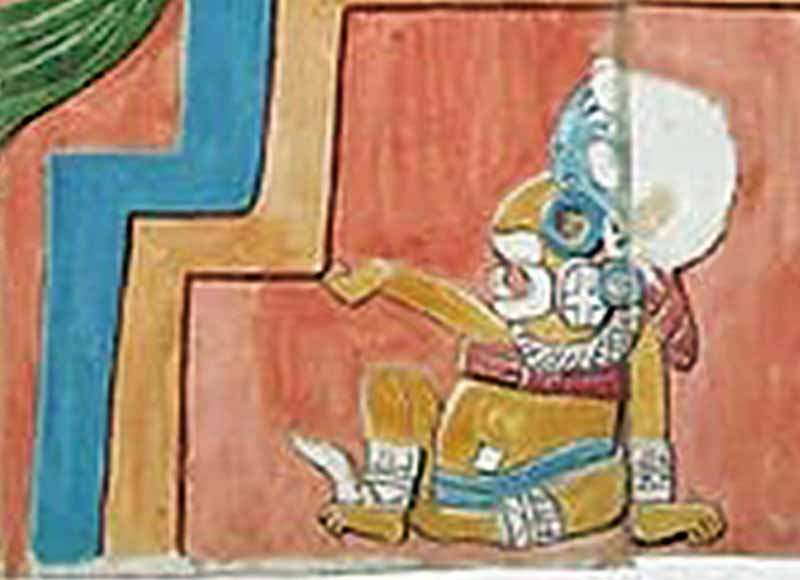
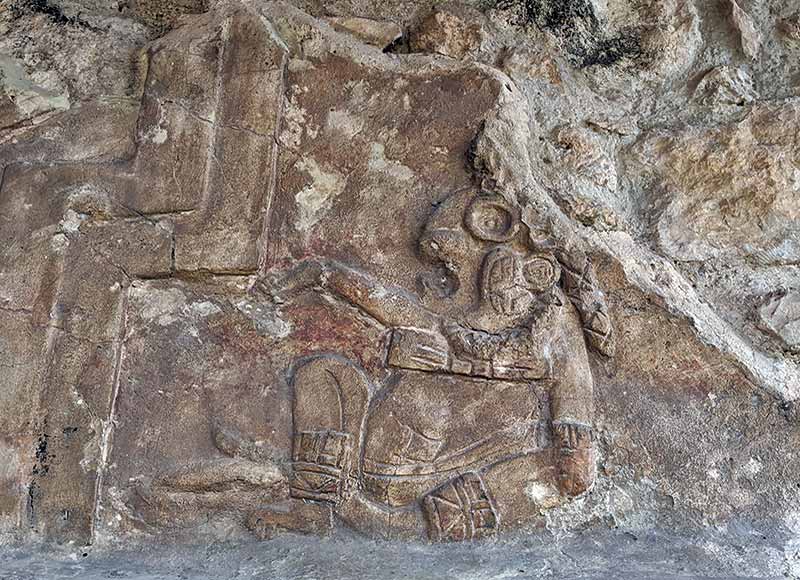
One of the more famous visitors of the time was Adela Breton. This English artist visited several Mayan ruins during the period, often at the request of photographers. She produced amazing colored artwork of different structures, capturing details that the early black and white cameras missed.
Her colored portrayal of the Acanceh friezes is often the only evidence we have of the stunning colors and artwork that has since deteriorated or damaged.
Sadly, by 1933, Mexican Miguel Fernandez reported that the wonderful frieze details noted by Maler in 1908 had already more or less gone (Explorations in Acanceh by Miguel Ángel Fernandez [1939])
In the two images above, the degradation and damage is clearly visible. Some of the original red paint survives in the image on the right but not much.
FAQs about Visiting Acanceh Mayan ruins
Where are the Acanceh Mayan ruins?
Acanceh is easy to visit from Merida – it’s only about 30 minutes by car.
Its size and the distance means it’s not worth visiting from the Riviera Maya.
The nearest Mayan Tren stop is at Merida.
How much is the entrance fee to Acanceh Mayan ruins?
The entrance fee to the Acanceh ruins is now MXN75.
There doesn’t seem to be any discount if you are a foreign resident or a Mexican citizen.
Can I climb any of the buildings at Acanceh Mayan ruins
You can climb the pyramids and the Palace of Stuccoes.
How long will a visit to Acanceh Mayan Ruins take?
That is entirely down to how interested you are in the ruins. It’s a small site and scattered across the town in three main sites. The walking distance between the site is probably only about 10 minutes but you are likely to take longer as you take in the quaint town.
You can easily spend 2 to 3 hours, and then more wandering the town or be finished in an hour.
What is the best time to visit Acanceh?
We’ve never seen crowds at the site, so you can drop in any time they’re open. If there is a small coach tour visiting, go across the road and have a drink – they won’t be long!
To avoid the worst of the heat when walking between the sites, the best months to visit are from November to April.
What should I bring for visiting Acanceh Mayan Ruins?
Cash.
Sunscreen.
Hat.
Good walking shoes.
Camera!
Is it safe to go to Acanceh?
The road to Acanceh from Merida is good.
We’ve always found the people in Acanceh to be very friendly.
I’ve never felt threatened or concerned when visiting Acanceh or on the drive there or back.
Obviously, like visiting any tourist attraction, keep your valuables out of sight!
Great Cenotes to Visit from Acanceh
Grotto and Cenote La Canderia
35 min or 13 miles (21.6 km) from Acanceh via YUC 10
Click here for more information about: The Grotto and Cenote La Canderia
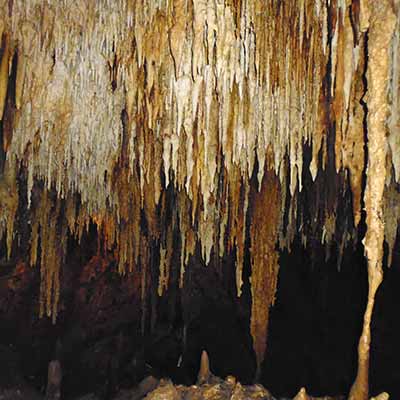
Cenote Yaxbakaltun
38 min or 14 miles (22.2 km) from Acanceh via YUC 10
Click here for more information about: Cenote Yaxbakaltun
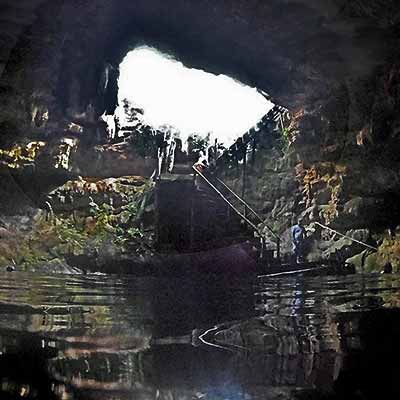
Santa Barbara Cenote
26 min or 11 miles (18.4 km) from Acanceh via YUC 10
Click here for more information about: Santa Barbara Cenote
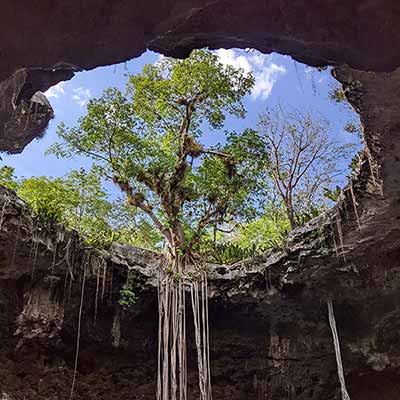
David H
After spending months in places like Playa del Carmen and Ajijic (near Lake Chapala, Guadalajara), my family and I have been living for the past four years in the Yucatan and enjoying this fabulous part of Mexico.
I've written many travel blogs for other travel sites over the years before starting Wonky Compass. I have three books published on Amazon.
Copyright 2024 www.wonkycompass.com